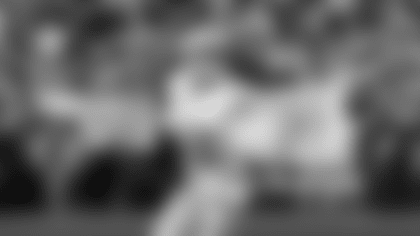Football is a game of strength, speed and skill - all of which can be affected by what, when and how much the player eats and drinks. Dr. Suzanne Nelson, the 49ers Sports Nutritionist, is widely considered to be an expert on the subject of Sports Nutrition. This week she shares her insight on how to optimize performance through proper Sports Nutrition.
Coach Carlisle (CC): How do you try to prevent and/or treat dehydration and muscle cramps in football players?
Dr. Nelson (DN): Contrary to what some people think, there is no way to train to prevent the adverse effects of dehydration. Players need to consistently consume sports drinks and water before, during and after practice and competition. In hot weather, they should be encouraged to drink more frequently.
Specifically, we encourage players to consume a sports drink like Gatorade before, during, and after practice. Guidelines are: 16-20 oz (450-600 ml) 1-2 hours before exercise, 7-10 oz (200-300 ml) every 15-20 minutes during exercise, and at least 24 oz (720 ml) after exercise for each pound lost. Players should weigh-in before and after practice to determine individual fluid losses. Monitoring body weight before and after each practice provides physical evidence that the athletes are taking personal responsibility for controlling their hydration levels. They need to recognize the warning signs of dehydration: dizziness or lightheadedness, cramping, nausea, fatigue, and dark-colored urine.
Some players are cramp-prone. These players tend to sweat early and very heavily. They typically have a history of cramping and produce sweat that tastes salty. Some are following a low-salt diet due to a family history of high blood pressure. They also tend to be the most fit and athletic players at their positions. For these guys, we add extra electrolytes (GatorLytes) to their Gatorade and have them drink 20 oz of salted Gatorade before games and practices; and drink Gatorade during the game, at the half, and after the competition. I encourage them to salt food at the training table; eat 2-3 salty snacks (popcorn, pretzels, crackers) each day.
CC: Do football players typically need diets that are different from those for most other sports? If so, how are football diets different?
DN: Overall energy (calorie) needs and specific nutrient requirements vary depending on time of season, body weight, maturity, personal food preferences, and position played. For example, an offensive lineman is focused on strength and power, whereas a running back is more concerned with quickness and agility. What they do on the field translates into the amount and type of fuel that they need at meals. While a lineman needs about 4,000 calories/day, a running back needs 6,500 calories/day to meet energy demands of his position. Along with planning meals for training table, snacks, and on the plane, I work with players individually to help them meet their specific nutrition and performance goals.
The timing of calorie intake is important to maximize performance and recovery. The ideal eating pattern is 5-6 high calorie meals/snacks throughout the day. Calorie needs should be met by consuming enough carbohydrate (8-9 g/kg or 4 g/lb of body weight) from foods such as fruit, whole-grain cereals and breads, brown rice, whole-wheat pasta, vegetables, legumes and some dairy foods to minimize fatigue and maximize training by replacing glycogen stores in muscle. Protein needs (1.6-1.7 g/kg or 0.8 g/lb body weight) should be met with lean protein sources such as lean meats, poultry, fish, dairy foods, egg whites, legumes, and nuts and seeds.

CC: What strategies do you recommend to maintain energy intake and lean body mass during two-a-days? What stresses do they face?
DN: It is typical for football players to engage in multiple practice sessions during the preseason. This practice format is common from the high school to the professional level. Obviously, the high-energy requirement, the opportunity for athletic injury, and the concerns about hydration status are heightened during this period. In addition to on-the-field physical practice sessions, lots of meetings are held. Frequent meetings add to the general fatigue syndrome experienced by athletes because the meetings and the time spent learning plays, cuts into time for naps and overnight sleep. During high-intensity training, like two-a-days, players may go into a catabolic state that results in loss of lean tissue due to hard training and from a cortisol response due to inadequate carbohydrate intake, dehydration, and heat stress. Adequate intake of carbohydrate can help diminish the cortisol response and may help spare lean body mass during these periods of tremendous physical stress.
When the interval between each training sessions is only four or five hours, it is essential to begin the rehydration and refueling process as soon as possible. Immediately after exercise, some athletes prefer to drink rather than eat, so encouraging them to drink a beverage that has carbohydrate and protein like a nutrition shake or yogurt-fruit smoothie immediately after exercise, and at hourly intervals up to the next training session, helps to replace fluids losses, and optimizes the rate of restoring the muscle glycogen that was used during the prior training session. The temptation to skimp on meals is also increased when the athlete tries to enjoy a full social life during the recovery between daily training sessions.
There is a relationship between nutrition and brain function, largely because nutrient intake can affect brain chemicals called neurotransmitters. During intense training, inadequate calories, and poor nutrition quality impairs performance and reduces the quality of training.
CC: How do proper eating habits and adequate rest affect the athlete's mental performance, be it in high-skill maneuvers on the athletic field or in cognitive performance?
DN: My experience has been that the most overlooked phase of any athlete's preparation is that of rest and recovery. We take measures to try to ensure that our athletes recover between individual practices, and lifting and after games as well. Sleep and nutrition are the most important aspects of recovery. Due to the great physical and mental demands placed on football players, if recovery methods are not implemented, there will likely be a drop in physical performance and mental acuity as well.
Featured Q&A with Parker
Q: What are good medicine ball workouts using the whole body? And do any NFL teams use kettlebells for their workouts?
A: To my knowledge, there aren't any NFL teams using kettlebells, but they are a time tested and proven method of training of weights to develop both strength and explosive power. You can do any exercise with medicine balls that you can do with weights, plus you can exercise in a variety of motions and movement patterns that aren't possible with weights. For example, spreading your feet and bringing the medicine ball from outside your foot diagnolly across your body. That's one of many examples that make medicine balls more versatile than weights because you are not limited in the movement pattern as you are with weights.






